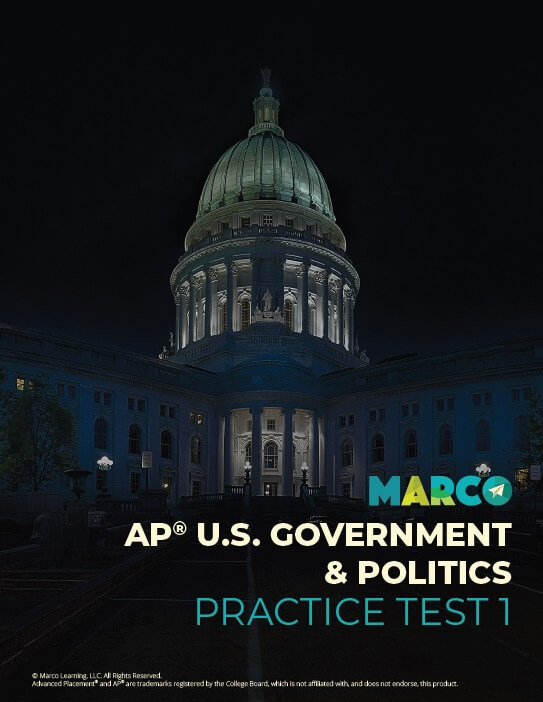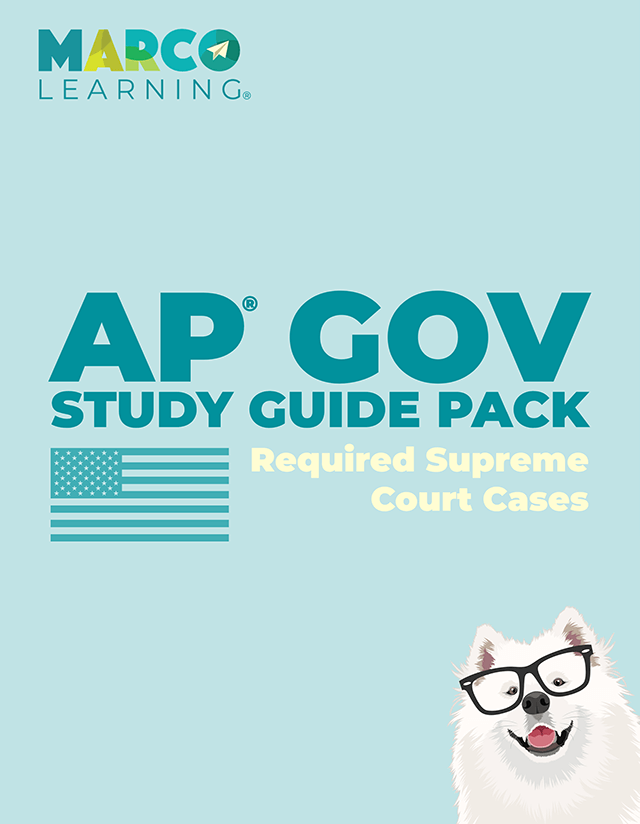


To score well on your AP® U.S. Government and Politics Exam, it is important to become familiar with all of the required Supreme Court cases. In the free-response section of your AP® U.S. Government Exam, you will have to answer four essay questions. The third of these questions is a SCOTUS comparison essay, in which you will be required to compare a non-required Supreme Court case with a required Supreme Court case, so get to know each required Supreme Court case as well as possible!
The required Supreme Court cases for the AP U.S. Government and Politics Exam in 2021 are:
Marbury v. Madison (1803)
McCulloch v. Maryland (1819)
Schenck v. the United States (1919)
Brown v. Board of Education (1954)
Engel v. Vitale (1962)
Baker v. Carr (1962)
Gideon v. Wainwright (1963)
Tinker v. Des Moines Independent Community School District (1969)
New York Times Co. v. United States (1971)
Wisconsin v. Yoder (1972)
Roe v. Wade (1973)
Shaw v. Reno (1993)
United States v. Lopez (1995)
McDonald v. Chicago (2010)
Citizens United v. Federal Election Commission (2010)
Roe v. Wade
Roe v. Wade is one of the required Supreme Court cases for AP® U.S. Government and Politics. This case resulted in the landmark decision establishing that pregnant women have a right to abortion without excessive government restriction as an expression of their right to privacy.
Tom Richey delves deeper into the facts of the case in this video:
FACTS OF THE CASE
In June 1969, a 21-year-old woman named Norma McCorvey learned that she was pregnant with her third child. After determining that she did not want to continue her pregnancy, she attempted to obtain an abortion in Texas, but was rejected because Texas law restricted abortion “for the purpose of saving the life of the mother.” She did not attempt to obtain an illegal abortion. Two attorneys filed suit on behalf of Norma McCorvey using the pseudonym “Jane Roe” against Henry Wade, the Dallas County District Attorney who represented Texas. Jane Roe’s legal team argued that the Texas law should be overturned both because it was overly vague and because it violated her right to privacy protected under the First, Fourth, Fifth, Ninth, and Fourteenth Amendments. A lower court ruled that the Texas law was unconstitutional on the grounds that it violated the Ninth Amendment and its implicit right to privacy. The case was appealed to the Supreme Court in 1970 and was scheduled to be heard in December 1971.
THE DECISION
In a 7-2 decision, the Court ruled that the “right to privacy” of the Fourteenth Amendment constitutionally protects a woman’s right to have an abortion.
The Texas Law that was at the heart of the case was considered unconstitutional because it was too broad in that it did not balance the different stages of pregnancy or any other mitigating factors. The decision established a constitutional right to abortion under a woman’s right to privacy. It balanced the State’s interests in protecting its citizens against the individual liberties of citizens by regulating each trimester of the pregnancy differently. The Court argued that the State may not regulate abortion in the first trimester, although it could regulate abortion for maternal health concerns in the second trimester and could prohibit abortion entirely in the third trimester.
IMPACT
The ruling in Roe v. Wade was controversial when it was first formed and continues to be divisive today. The two dissenting Supreme Court judges wrote scathing dissents that criticized the Court’s use of the Fourteenth Amendment to regulate abortion. Justice Bryon White asserted that the decision showed that “The Court simply fashions and announces a new constitutional right for pregnant women” without sufficient constitutional backing. Justice William Rehnquist, who also dissented, argued that “to reach its result, the Court necessarily has had to find within the scope of the Fourteenth Amendment a right that was apparently completely unknown to the drafters of the Amendment.” These objections have become major points of criticism in the ongoing debate over Roe v. Wade. As it stands, Roe v. Wade continues to provide precedent for abortion law in the United States, although subsequent cases have modified the trimester structure in the ruling and allowed states to place more regulations on first-trimester abortions as long as they do not represent an “undue burden” on women.

PRECEDENT
Miller v. Johnson (1995)—Roe v. Wade was the first Supreme Court case to specifically legislate issues around abortion. While it does not have a direct judicial precedent, the court ruling relied extensively on the due process clause of the Fourteenth Amendment, which argues that “…nor shall any state deprive any person of life, liberty, or property, without due process of the law” and rights to privacy extended by the Constitution.
SUBSEQUENT CASE
Planned Parenthood v. Casey (1992)—ruled that while the essential holding of Roe v. Wade (1973) was valid, it needed to be modified. The Court rejected the trimester standard in favor of a viability standard. The Court determined that states could impose some restrictions on abortions prior to the point of a fetus’s viability as long as those restrictions did not represent an “undue burden.”
KEY TERMS
Abortion The decision in Roe v. Wade focused on the right of Jane Roe to access an abortion, which is the medical termination of a pregnancy through either medication or surgery. The Roe v. Wade ruling framed abortion as a private medical decision between a woman and her physician.
Viability While the ruling for Roe v. Wade used the trimester system to determine when abortion could be performed, subsequent rulings on the topic have focused on viability. Viability is the point at which a fetus can live outside a mother’s womb. The point of viability is generally considered to be 28 weeks, but advances in medical technology have moved that up to 24 weeks.
The best way to get better at something is by practicing.
That’s why it’s so important that you take practice tests to help you get better at the AP® U.S. Government and Politics Exam. Only then can you expect to get a good score—and even improve your score.
 Help
Help